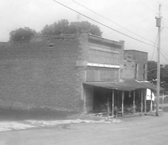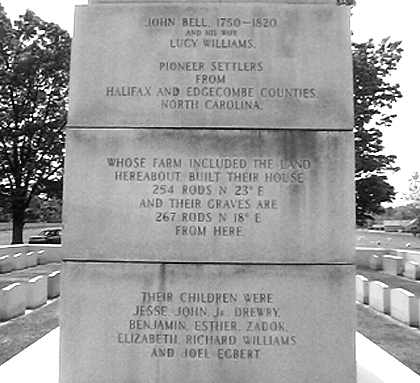The Bell Witch: The Full Account (45 page)

however, Native American hostility was so great in
the area that he remained for less than a year.
Albert Virgil Goodpasture relates the following
detailed account of Thomas Kilgore’s early
settlement:
“The first settlement in Robertson County {The
facts in regard to Kilgore's settlement were
condensed from the articles written by Dr. J.S.
Mulloy, for the Springfield Record} was made by
Thomas Kilgore on the waters of the Middle Fork
of Red River, three-fourths of a mile west of Cross
Plains. The Legislature of North Carolina passed
a preemption law securing to settlers of Tennessee
640 acres of land, provided the settlement was
made prior to 1780.
In the spring of 1778, Kilgore left North Carolina
with some ammunition, some salt, and a few
grains of corn. Traveling on foot, he passed
through East Tennessee and plunged into the
wilderness beyond. Guided alone by the sun and
the North Star, he pushed on, seeing no white
334 P A T
F I T Z H U G H
people until he reached Bledsoe's Lick, where he
found a colony of six or eight families. After
resting a few days, he went on some twenty-five
miles west where he located.
As a safe hiding place from the Indians, he
selected a cave a mile west of where Cross Plains
now is. It had a bold stream of water running
from it into the Middle Fork of Red River, and by
wading through the stream he could enter the
In the spring of 1779, with a few families besides
his own, he returned to the spot where he had
passed the previous summer. A stockaded fort,
“Kilgore's Station” was at once erected to protect
them from the Indians. This fort was situated on
a commanding eminence, about three-fourths of a
mile from Cross Plains. Kilgore's Station, from
that time for years, was a landmark in the
overland emigration to Tennessee.
Thomas Kilgore, after living half a century on the
land which he had acquired by his heroics, died
at the advanced age of one hundred and eight
years.” 85
A number of families settled in the area over the
next few decades, including the Forts, Gunns,
Gardners, Norfleets, Bells, Gooches and others.
During this time, “war parties” ravaged the early
frontier – killing white settlers and burning their
homes. Despite the signing of a peace treaty as early
as 1777, the brunt of attacks on the early settlers of
Robertson County did not come until the early
1780’s, when several renegade groups of Cherokees
and Creeks formed what became known as the
85 Albert Virgil Goodpasture,
Goodspeed History of Tennessee – Robertson County
, 1886, p. 829 [Edited by Pat Fitzhugh].
THE BELL WITCH: THE FULL ACCOUNT
335
Chickamauga Nation, whose purpose was to reclaim
their land despite the existence of peace treaties.
After a failed attack on Fort Nashboro, which later
became known as Nashville, the Chickamaugans
headed north and raided early settlements all along
the Red River, carrying out brutal and relentless
attacks that often signaled the demise of the
settlements and their inhabitants. This series of
attacks marked the beginning of a reign of terror that
lasted almost a decade.
Over time, many of the settlers armed themselves
and casualties gradually lessened. The fall of the
Chickamauga Nation began in 1792, after its chief
allegedly had a heart attack and collapsed after a
prolonged and drunken war dance. Another chief
soon replaced
him, and the brutal attacks continued
over the next two years. The new chief finally sued
for peace and signed a treaty in 1794, after which
time the attacks in middle Tennessee subsided
greatly.
Most of the area along the Red River is in present-
day Montgomery and Robertson Counties, although
the area was originally part of Tennessee County,
North Carolina before Tennessee became a state in
1796. The new state was divided into counties and
Robertson County was named for James Robertson,
the founding father of nearby Nashville.
During the time of John Bell, Robertson County
had a population of 9,938. 86 The primary goods
produced in early Robertson County were whiskey
and cotton. Albert Virgil Goodpasture describes the
importance of these staples in Robertson County’s
early economy in his book,
Goodspeed History of
Tennessee – Robertson County
:
86 Albert Virgil Goodpasture,
Goodspeed History of Tennessee – Robertson County
, 1886, p. 836.
336 P A T
F I T Z H U G H
“The manufacture of whisky and brandy has
always been an important industry in Robertson
County. In the earlier days, small distilleries were
found in almost every hollow, and it is said that
on some streams there was a stillhouse every 100
yards.
These establishments had a capacity of not more
than thirty or forty gallons per day, and the
whisky was manufactured by what is known as
the ‘sour-mash’ process. The honesty and care
used in making the whiskey gave it a high
reputation, which it has since maintained.
One of the first distilleries in the county was
erected near Cross Plains by Daniel Holman,
about 1798. In the same year, another distillery
was built near Turnersville by Mr. Grider. The
Woodards were also among the first distillers of
the county.
During the first fifty years after the settlement of
the county, cotton was a crop of some importance.
Nearly every farmer raised enough to clothe his
own household, and after the invention of the gin,
considerable quantities were shipped. Among the
gins and presses in use in 1804 were those of
Archer Cheatham, in Springfield, and John
McMillan, near Cross Plains. The cultivation of
cotton began to decline about 1830, and it was
not long until its production practically ceased.” 87
Cotton was later replaced by tobacco as the
county’s most prized crop. Over the years, Robertson
County earned its reputation as the dark-fired
tobacco capital of the world.
87 Albert Virgil Goodpasture,
Goodspeed History of Tennessee – Robertson County
, 1886, p. 828 [Edited by Pat Fitzhugh].
THE BELL WITCH: THE FULL ACCOUNT
337
Appendix E:
The Town of Adams, Tennessee
A DAMS IS LOCATED about 10 miles
northwest of Springfie
ld
, Tennessee and 7
miles south of Guthrie, Kentucky. The
town, first called “Red River Station,” was changed to
“Adams Station” in honor of a local merchant,
landowner and railroad stockholder, Reuben Adams,
when the first railroad depot and post office were
built in 1860. 88 The Edgefield and Kentucky
Railroad connected nearby Guthrie, Kentucky with
the Edgefield community just north of present-day
Nashville.
The town was first incorporated on November 10,
1869. The first Charter was repealed in 1899, and
the town did not incorporate again until the 1908-
1909 period. ll The size of the town was measured
as, “120 rods in each direction from the center of the
depot.” 89
The town’s first newspaper, “The Adams
Enterprise,” was started by Charley Willett and
remained in circulation for about six years. Willett
later became a professional baseball player, a
successful attorney, the Mayor of Adams, and a
Tennessee State Senator.
Adams Station became known simply as “Adams”
88 Albert Virgil Goodpasture,
Goodspeed History of Tennessee – Robertson County
, 1886, p. 832.
89 Ralph Winters,
Historical Sketches Adams, Robertson County and Port
Royal/Montgomery County TN
, 1978, p. 47.
338 P A T
F I T Z H U G H
on February 10, 1898, and the Edgefield and
Kentucky Railroad became known as the Louisville
and Nashville Railroad when the trunk line was
extended from Guthrie to Louisville, Kentucky. 90
Located along what was the main railroad and
highway between Nashville and Louisville for many
years, Adams was a thriving town with many
residents and businesses. Tennessee historian Albert
Virgil Goodpasture describes Adams during its
heyday:
“The first store-house was built and occupied by
Adams & Holloway, who carried on a grocery
business. At about the same time, B. O.
Crenshaw opened a drygoods store. During the
Civil War, nearly all buildings were destroyed. In
1866, only three dwellings remained in the town.
About 1865 C. M. Brown & Co. established a
general merchandise business in the depot. A
little later, Capt. Thomas Mallory built a
storehouse on the lot now occupied by J. C.
Moody's drug store, and a business was
conducted there under the firm name of J. E.
Ruffin & Co.
The present business interests of the town are
represented by J. E. Gaines, W. S. Miller and
Redding & Cobb, drygoods; J. C. Murphey and
Winters & Head, groceries; W. H. Howsley,
general merchandise; J. S. Moody, drugs; Crouch
& Co., and Hallums & Edwards, tobacco dealers;
G. A. Farmer, flouring-mill; Alsbrooke &
Robinson, Blacksmiths; and J. T. Bell and J. C.
Moody, physicians [Editor’s Note: J.T. Bell was
Dr. Joel Thomas Bell, son of John Bell, Jr.].
90 Ralph Winters,
Historical Sketches Adams, Robertson County and Port
Royal/Montgomery County TN
, 1978, p. 44.

THE BELL WITCH: THE FULL ACCOUNT
339
The town has two churches, Methodist and
Missionary Baptist. The school under the
principalship of S. A. Link is one of the best in
the county.” 91
The railroad’s abandonment of passenger service
through Adams and the construction of Interstate
24, both occurring in the Twentieth Century, took a
heavy toll. A number of businesses were forced to
close, and most buildings in
what was once the central
business district have long
since been destroyed or
boarded up.
Adams’ best-known citizen
was (is) none other than the
“Kate.” Small signs at the east
and west city limits along
Highway 41 say, “Welcome to Adams,” and display a
carved-out picture of a witch riding a broom.
Coming into Adams from the east on Highway 41,
the first landmark one will see is Bellwood Cemetery,
which is situated on the right-hand side of the
highway. Towards the back of the cemetery lies a
monument dedicated to John Bell and his
descendants, which reads:
John Bell 1750-1820 and his wife Lucy Williams
Pioneer Settlers from Halifax & Edgecombe Co., N.C.
Their children were
Jesse, John Jr., Drewry, Benjamin, Esther, Zadok,
Elizabeth, Richard Williams and Joel Egbert
91 Albert Virgil Goodpasture,
Goodspeed History of Tennessee - Robertson County
, 1886, p. 845 [Edited by Pat Fitzhugh for clarity, grammar and spelling].
